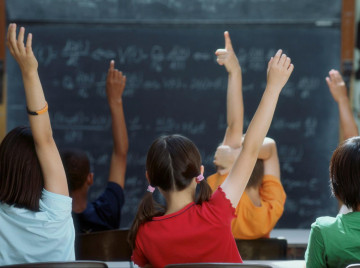The Highest + Lowest Performing Charter Schools in RI
Thursday, September 26, 2013
Charter schools vary widely in the performance of their students, with some soaring far above the statewide average while others lag behind their peers and even other public schools, data from a local education advocate shows.
In the public eye, charters are often perceived as a kind of super school: a hybrid between public and private that gives more choices to parents, more flexibility to teachers, more autonomy to administrators, and, ultimately more opportunities to excel for students—especially those who hail from inner city environments where the odds are often against them.
Some charter schools do achieve such high standards, but others don’t, according to data culled from the Rhode Island Campaign for Achievement Now (RI-CAN).
GET THE LATEST BREAKING NEWS HERE -- SIGN UP FOR GOLOCAL FREE DAILY EBLASTClick here to view the ranking of the charter schools in Rhode Island.
“Charter schools can do a lot of good things, but there’s nothing inherently good about them, and they can fail just like any other school. The data back this up, both data I’ve seen and the data you’re writing about. A good school is a good school, whoever is running it,” said Tom Sgouros, a progressive blogger and policy analyst who has written extensively on education issues.
Charter schools: mixed results
Among the eight charters at the elementary level, four outperformed the statewide average for student test scores in public schools, while four were below it.
“The fact is that our public schools do far better for our students than is widely appreciated, especially when you consider what has happened to their budgets over the past decade. A lot of their success is masked by statistical artifacts and this allows education ‘reformers’ to claim they are failing. Several of those artifacts are the result of the huge inequalities that plague our public schools,” Sgouros said.
Near the top the of the charter elementary schools was The Compass School in South Kingstown, which RI-CAN grades at 100 percent for the performance of its students on standardized tests. Near the bottom was the Times2 Academy in Providence, at 59.5 percent—a “C” on the grading scale used by RI-CAN.
The statewide average was 67 percent.
Of course, the two schools serve quite different populations. At The Compass School, just 4 percent of its 161 students are minorities while 12 percent are on a free or reduced lunch program—one of the more common measures of students from low-income households in public schools. Contrast the Times2 Academy, which, at the elementary level, has a student population roughly four times the size, with 96 percent minority and 77 percent free or reduced lunch.
In the context of the Providence School District, Times2 elementary students are outpacing their peers, who had a 41.5 percent performance. (The percentages, or “grades" as RI-CAN calls them, are the average number of students proficient in the NECAP reading and math exams. The latest data is based on the fall 2012 assessments.)
Similar patterns emerge in the data for the charter schools at the middle and high school levels.
Among the middle schools, six are above the state average for student performance, while two are below. The middle schools range widely, from top grades of 89.6 percent to a low of 49.7 percent. (The grades take into account overall student performance and specifically how key subgroups of students, like Latinos or low-income students, are doing.)
Charters are again split at the high school level: four are above the state average and four are below it, with a 31.9-point gap between the top and bottom performers—the Blackstone Academy Charter School in Pawtucket and the New England Laborers Construction Career Academy in Cranston, respectively.
Best charters have their own unique formula for success
There are three different kinds of charter schools in Rhode Island: in-district charters, independent charters, and mayoral academies. In-district charters have the most restrictions, while the mayoral academies have the most flexibility. The more flexibility and freedom to make big changes at the drop of a hat, some education reformers would say, is conducive to higher student achievement.
That might explain why, at the middle-school level, the Blackstone Valley Prep, a mayoral academy, leads the pack.
But others say the reasons why charters succeed or struggle vary widely, and often are connected to the particular conditions of each school.
“I think our homegrown charters are working very hard to work with their families and the population and the environment they’ve got,” said Julia Steiny, an education reformer who is a regular columnist for GoLocalProv and a consultant for school and government initiatives.
Each of the “homegrown” charters has its own formulas for success, Steiny said. The Times2 Academy closely resembles the highly structured environment of a Catholic school—students wear uniforms and are required to line up for school, Steiny said. In Woonsocket, the Beacon Charter High School uses the arts to engage students and reinforce academics, she added.
Charters also vary widely in terms of their environment. In South Kingstown, The Greene School uses the freedom and flexibility that are part and parcel of the charter school experience to boost the performance of a student population that faces few of the difficulties minority and low income students have. That combination of charter school advantages and a relatively “easy” population explain why The Greene School is the third highest performing charter at the high school level, according to Steiny.
Then, there are the charters whose mission is working with inner city students. The International Charter School in Pawtucket, for example, has a population with 50-percent non-native English speakers. The school runs a dual-language immersion program.
Steiny contrasted the “homegrown” charters—which dominate Rhode Island—with those that are part of out-of-state networks. The new Achievement First school is an example of the latter, Steiny said. “It’s a corporate charter. It’s corporate like McDonald’s,” she said. “It’s got a corporate structure like McDonald’s that is franchise-able.”
Why some charters struggle
Likewise, those charter schools that aren’t at the top face their own unique set of challenges.
“Cranston’s Laborers effectively serves as Cranston’s alternative high school, so kids who are not making it in the regular two schools tend, not always, but tend to wind up at Laborers. If you look at InfoWorks—you’ll see that they have double (30 percent) the state average for special needs kids 15 percent—whereas the regular high schools have 12 percent and 16 percent, far from double,” Steiny said.
But educational or economic demographics aren’t the only issue. For the Paul Cuffee Charter School, which was the next-lowest ranking at the high school level, the issue appears to largely be one of timing, according to Steiny.
“Last year was the first time Cuffee took the high school test, and it usually takes a school a couple of years to adjust to testing,” Steiny said. “They deserve a break.”
Indeed, students in the middle and elementary grades at Cuffee are performing better. The middle school students score about 7 points above the statewide average and the elementary students are ahead by almost the same margin.
When demography isn’t destiny
Despite the overall mixed results, the Rhode Island charter community has some truly compelling stories of triumph against all the odds. One is the Blackstone Valley Prep, which ranks as the highest-performing charter at the middle school level.
The odds are certainly against the students: at the middle school level 65 percent are on the free or reduced lunch program and almost as many come from minority backgrounds. (The school also has elementary grades.)
But the school scores 89.5 percent on the RI-CAN grading scale for student performance, above the state average of 56.5 percent. Minority and low-income students, in particular, perform at an average of 89.7 percent proficiency against an average of 49.7 percent for minority and low-income students statewide.
“BV Prep has actually inverted the achievement gap, proving a lie to the myth that demographics determine a student’s destiny. BV Prep performs better than almost any other public school in the state for three reasons: high expectations for all children, more time in school, and most importantly, great teachers,” said Angus Davis, a local entrepreneur who is on the board for the Rhode Island Mayoral Academies (of which Blackstone is one; the other is Achievement First).
“As President Obama said, ‘From the moment students enter a school, the most important factor in their success is not the color of their skin or the income of their parents. It’s the person standing at the front of the classroom.’ For anyone who wants to see what President Obama is talking about, I’d encourage them to visit BV Prep where the doors are always open,” Davis added.
Stephen Beale can be reached at [email protected]. Follow him on Twitter @bealenews
Related Articles
- Julia Steiny: Top Charter School Responds to Needs of Business
- NEW: Governor Visiting Charter School In New Haven Today
- Providence Goes to War over Charter Schools
- NEW: ACLU Opposed to Providence City Charter Revision
- NEW: Letter to ACLU Claims Pool Closing Violates City Charter
- Public or Private: Charter Schools Can’t Have It Both Ways
- NEW: Brown University to Partner with Prominent Charter School Organization
- NEW: Mayors Urge Chafee to Support New Charter School
- RI Charter Schools See Huge Increase in Applications
- Charter School Critics Blast Graduation Claims
- NEW: Central Falls to Create Charter Review Commission
- NEW: New Charter School To Open In Providence
- Report—Charters Will Help All Public Schools
- Commissioner Gist Recommends Closure of Failing Providence Charter School
- NEW: Chafee Points to Opposition to New Charter School
- NEW: Online Charter School Opening in RI
- Julia Steiny: A Charter School That Educates ALL Kids
- NEW: Charter Public School Consortium to be Held Tuesday
- NEW: Providence Charter Review Commission Elects Chairperson
- Julia Steiny: Can Charter Schools Save Providence?
- NEW: Charter School Lotteries Take Place in March
- NEW: Providence Charter Review Commission to Hold First Meeting
- Julia Steiny: International Charter School a Real Success
- NEW: Charter School Opponents Form Website
- NEW: Supporters to Rally Against Charter School Closure







